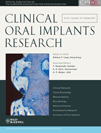Primary stability and self-tapping blades: biomechanical assessment of dental implants in medium-density bone
Abstract
Aim: The aim of this biomechanical study was to assess the influence of self-tapping blades in terms of primary implant stability between implants with self-tapping blades and implants without self-tapping blades using five different analytic methods, especially in medium-density bone.
Materials and methods: Two different types of dental implants (4 × 10 mm) were tested: self-tapping and non-self-tapping. The fixture design including thread profiles was exactly the same between the two groups; the only difference was the presence of cutting blades on one half of the apical portion of the implant body. Solid rigid polyurethane blocks with corresponding densities were selected to simulate medium-density bone. Five mechanical assessments (insertion torque, resonance frequency analysis [RFA], reverse torque, pull-out and push in test) were performed for primary stability.
Results: Implants without self-tapping blades showed significantly higher values (P<0.001) in four biomechanical assessments, except RFA (P=0.684). However, a statistically significant correlation could not be detected between insertion torque values with the four different outcome variables (P>0.05).
Conclusions: The outcomes of the present study indicate that the implant body design without self-tapping blades has a good primary stability compared with that with self-tapping blades in medium-density bone. Considering the RFA, a distinct layer of cortical bone on marginal bone will yield implant stability quotient values similar to those in medium-bone density when implants have the same diameter.
To cite this article: Kim Y-S, Lim Y-J. Primary stability and self-tapping blades: biomechanical assessment of dental implants in medium-density bone.Clin. Oral Impl. Res. 22, 2011; 1179–1184.doi: 10.1111/j.1600-0501.2010.02089.x




